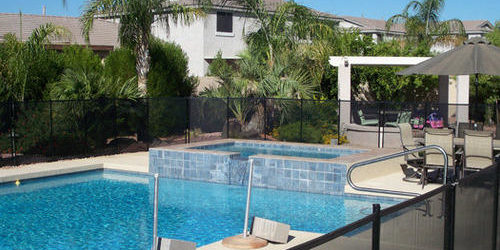Should you Cover or Fence your pool?
Limiting access to your pool is important for everyone, as accidents can happen at any time. Those with children in the home need to be especially vigilant in limiting access when children are unsupervised. There are two main options for limiting access; cover or fence your pool.
Pool Safety Cover or Fence Your Pool
Pool safety nets or covers are put across the pool and pulled tight to create a seal and prevent access while not in use.
-
Installation
These are installed using bolts around the exterior of the pool which the coverings are fastened. This requires drilling into the concrete patio around the pool about every two feet to provide anchor points. This needs to be done by a professional, and you should have the cover or net specifically designed to match the shape and size of your pool to create the best fit.
-
Pros
Pool safety nets and covers, when installed properly, are effective at limiting access to the pool. In order to be installed properly ladders and anything else protruding from the pool must be removed prior to covering every time.
-
Cons
These tend to be less convenient because they have to be removed and replaced after every use. If parents are not diligent in immediately replacing the cover, the benefits are lost. If you use your pool frequently this can become a hassle quite quickly. Additionally, if you do not properly fasten the covers every time there can be loose space where a child could still access the pool, while the covering would limit your ability to reach them.
Although there are some drawbacks, pool safety nets and covers can be great options if you are diligent and use them properly.
Pool Safety Fences
Pool safety fences are a special type of fencing, specifically designed to enclose a pool. These come in several types including glass, metal, or mesh to best fit your needs.
-
Installation
Installation of pool safety fences should also be done by a professional, although it is possible to do it yourself. These require drilling into the concrete pad around the pool to provide anchor points for the posts.
-
Pros
Pool safety fences are a more convenient option for those who use their pools frequently. Once set up only a self latching gate stands between you and time in your pool. Some variations of pool safety fences are removable; meaning an adult could remove the fence in about 10 minutes for a party or other event where the fence was not desired.
-
Cons
Pool safety fences don’t act as a pool cover to keep debris and leaves out. Additionally, if you don’t fully close the gate after use the fence will not be effective.
Pool safety fences will allow you the peace of mind knowing that your children can’t find their way into the pool without you knowing, and don’t require the same set up as other pool safety equipment. Pool safety nets and covers can be effective but require additional work every time you use the pool to recover after. This is why most people find pool safety fences to be the best option to restrict access.
Additional Safety Measures
-
Supervision
While limiting access with a cover or fence your pool, one of the most important steps for pool safety the number one thing you can do to keep children safe is monitor them while swimming. There is no substitute for proper supervision.
-
Pool Alarms
Depending on the type of pool alarm you choose they will alert you if a pool fence is opened or if the water is disturbed by a child falling in. These can be a great addition to limiting access if additional security is desired.
Some parents are afraid to have pools in their yard in case an accident ever did happen. By taking these precautions you can enjoy the use of a pool while feeling confident that your family is safe. Monitoring your children and using a pool fence as a barrier means that you can enjoy the pool without worrying when you aren’t.





